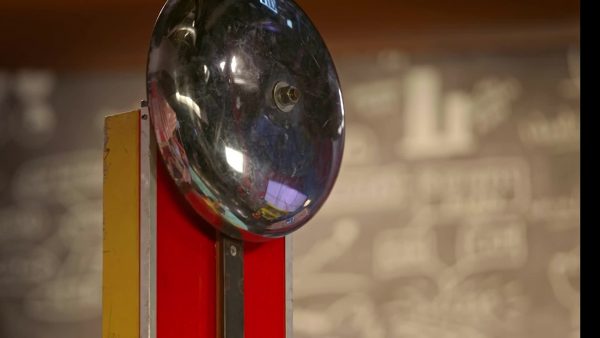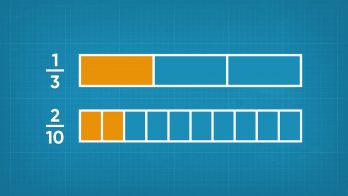Non-Equivalent fractions represent different fractions of a whole. You can use common denominators to compare fractions.
To better understand comparing non-equivalent fractions…
LET’S BREAK IT DOWN!
Balloons

Adesina, April, and Marcos prepare balloons for a party. They have one helium tank that is [ggfrac]3/4[/ggfrac] full, and another that is [ggfrac]2/5[/ggfrac] full. Which tank is more full? The two fractions have different denominators, which makes it harder to directly compare them. One way we can compare fractions is by using a benchmark fraction. Let’s use [ggfrac]1/2[/ggfrac] as a benchmark. Since [ggfrac]1/2[/ggfrac] is equivalent to [ggfrac]2/4[/ggfrac], we can see that [ggfrac]3/4[/ggfrac] is more than [ggfrac]1/2[/ggfrac]. We also know that [ggfrac]2/5[/ggfrac] is less than [ggfrac]1/2[/ggfrac]. Then, since [ggfrac]2/5[/ggfrac] is less than [ggfrac]1/2[/ggfrac], and [ggfrac]3/4[/ggfrac] is more than [ggfrac]1/2[/ggfrac], [ggfrac]3/4[/ggfrac] is greater than [ggfrac]2/5[/ggfrac]! Now you try: Use a benchmark fraction to determine which is greater, [ggfrac]5/8[/ggfrac] or [ggfrac]3/7[/ggfrac].
Remote Control Cars

April and Marcos drive remote control cars. Both cars have the same size battery. Marcos’s car has [ggfrac]2/3[/ggfrac] of its battery power left, and April's car has [ggfrac]5/6[/ggfrac] left. Whose battery has more power left? Since both [ggfrac]2/3[/ggfrac] and [ggfrac]5/6[/ggfrac] represent more than [ggfrac]1/2[/ggfrac], we can't use the benchmark of [ggfrac]1/2[/ggfrac] to compare them. Instead, we can use common denominators. We can use our knowledge of equivalent fractions to rewrite [ggfrac]2/3[/ggfrac] and [ggfrac]5/6[/ggfrac] so that they have the same denominator. 3 x 2 = 6, so we can multiply the numerator and denominator of [ggfrac]2/3[/ggfrac] by 2 to get an equivalent fraction with a denominator of 6. [ggfrac]2x2/3x2[/ggfrac] = [ggfrac]4/6[/ggfrac]. Now we compare [ggfrac]4/6[/ggfrac] to [ggfrac]5/6[/ggfrac]. Both fractions have the same denominator, so we can compare the fractions using their numerators. 5 > 4, so [ggfrac]5/6[/ggfrac] is greater than [ggfrac]4/6[/ggfrac]. April's battery has more power left. Now you try: Use common denominators to compare [ggfrac]3/5[/ggfrac] and [ggfrac]7/10[/ggfrac].
Carnival

April and Marcos are at a carnival strength challenge. They swing a mallet and a machine records the strength of the blow, up to a marker. Marcos strikes with his mallet and he scores [ggfrac]3/4[/ggfrac] of the way to the marker. April strikes with her mallet and she scores [ggfrac]4/5[/ggfrac] of the way to the marker. Who got the greater score? We can use equivalent fractions to compare. 5 is not a multiple of 4, so we need to rewrite both fractions to make the fractions have a common denominator. Some equivalent fractions of [ggfrac]3/4[/ggfrac] are [ggfrac]6/8[/ggfrac], [ggfrac]9/12[/ggfrac], [ggfrac]12/16[/ggfrac], [ggfrac]15/20[/ggfrac], and [ggfrac]18/24[/ggfrac]. Some equivalent fractions of [ggfrac]4/5[/ggfrac] are [ggfrac]8/10[/ggfrac], [ggfrac]12/15[/ggfrac], and [ggfrac]16/20[/ggfrac]. Both fractions have an equivalent fraction with a denominator of 20: [ggfrac]3/4[/ggfrac] = [ggfrac]15/20[/ggfrac] and [ggfrac]4/5[/ggfrac] = [ggfrac]16/20[/ggfrac]. Now that the fractions have the same denominator, we can compare the numerators. 16 > 15, so [ggfrac]16/20[/ggfrac] > [ggfrac]15/20[/ggfrac]. Since [ggfrac]16/20[/ggfrac] = [ggfrac]4/5[/ggfrac], and [ggfrac]15/20[/ggfrac] = [ggfrac]3/4[/ggfrac], we know that [ggfrac]4/5[/ggfrac] > [ggfrac]3/4[/ggfrac]. There is a faster way to find the common denominators than listing equivalent fractions. For each fraction, multiply the numerator and the denominator by the denominator of the other fraction. For example, to compare [ggfrac]3/4[/ggfrac] and [ggfrac]4/5[/ggfrac], multiply [ggfrac]4/5[/ggfrac] by [ggfrac]4/4[/ggfrac] to get [ggfrac]16/20[/ggfrac], and multiply [ggfrac]3/4[/ggfrac] by [ggfrac]5/5[/ggfrac] to get [ggfrac]15/20[/ggfrac]. That was faster! Now you try: Use common denominators to decide which is greater, [ggfrac]6/7[/ggfrac] or [ggfrac]4/5[/ggfrac].
Marathon

April and Marcos are training for a race. April ran [ggfrac]3/5[/ggfrac] of a mile and Marcos ran [ggfrac]5/6[/ggfrac] of a mile. Who ran farther? We need to find a common denominator to compare fractions that have different denominators. Multiply the numerator and denominator of [ggfrac]3/5[/ggfrac] by 6: [ggfrac]3x6/5x6[/ggfrac] = [ggfrac]25/30[/ggfrac]. Multiply the numerator and denominator of [ggfrac]5/6[/ggfrac] by 5: [ggfrac]5x5/6x5[/ggfrac] = [ggfrac]25/30[/ggfrac]. Now that the denominators are the same, compare the numerators. Since 25 > 18, [ggfrac]25/30[/ggfrac] > [ggfrac]18/30[/ggfrac]. So[ggfrac]5/6[/ggfrac] > [ggfrac]3/5[/ggfrac]. Now you try: Which is greater, [ggfrac]2/3[/ggfrac] or [ggfrac]3/4[/ggfrac]?

































































































































 Select a Google Form
Select a Google Form






 GENERATION GENIUS
GENERATION GENIUS




